A vast number of households in Aotearoa with a child of 10 or under will be intimately familiar with the engaging, vibrant work of Brian Lovelock. How many times can a three-year-old want to read Roadworks or Construction in a row? Brian’s latest collaboration with author Sally Sutton, Wheels, has recently hit shelves, so Sarah Forster asked him a few choice questions about his work.
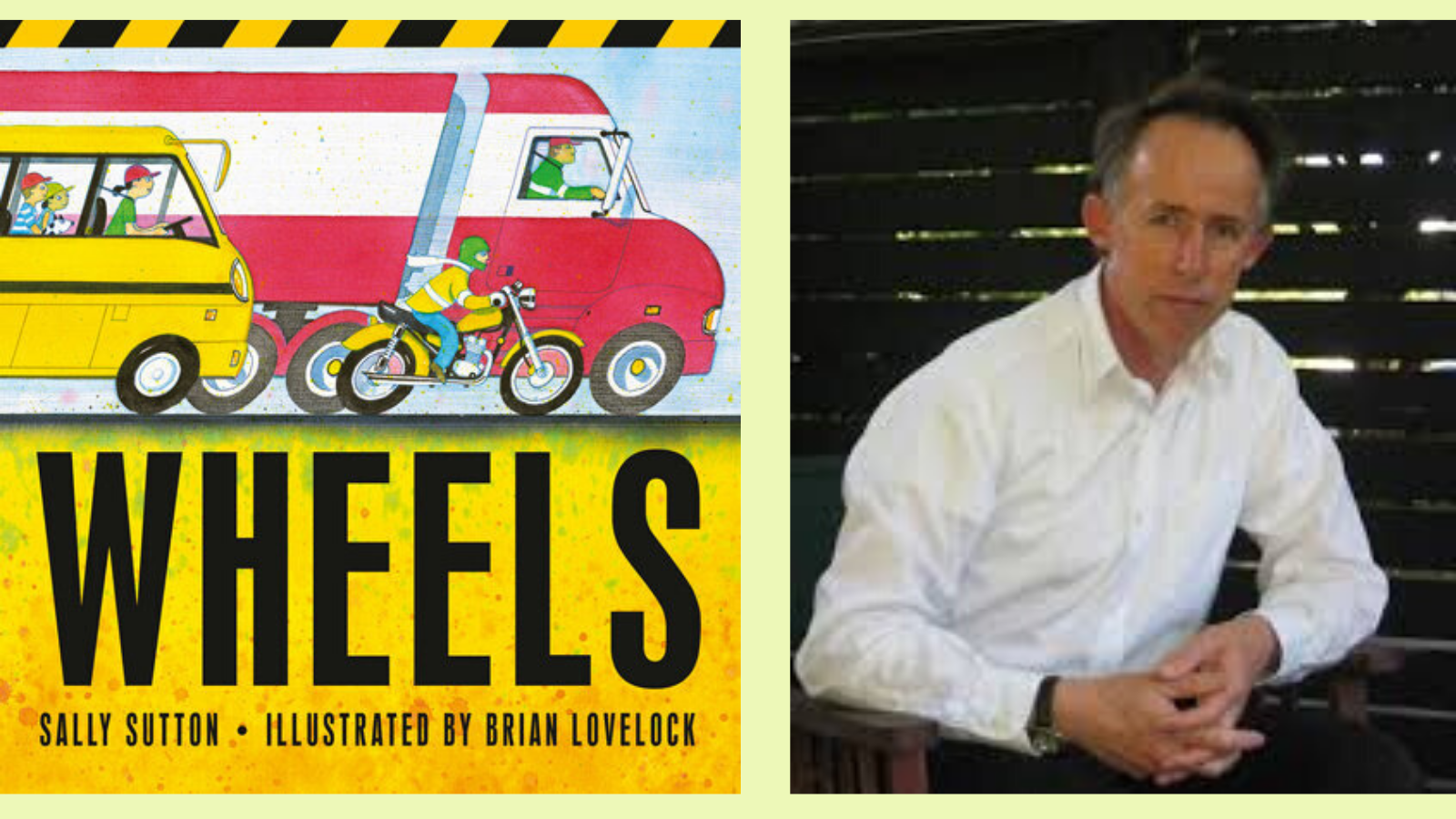
Sarah: I have always admired your illustrations for their mix of clean geometrical lines contrasted with softly rendered people – can you take me through how you drew one of the spreads in Wheels?
Brian: I illustrate on sheets of Fabriano hot-press paper, generally about 20 per cent larger than the published book. For the picture below I would begin by drawing in pencil, using the preliminary storyboard image to guide me. Once I’m satisfied with the drawing, I over-draw in indelible ink (usually dark blue). I then apply acrylic paint to areas that I want to be waterproof (e.g. rooftops, areas of black and fine speckles I flick over the pages for texture). I mask out the areas where I want to preserve the white paper (e.g. windows, high-vis strips on the workers). I then paint in the coloured areas and finally quickly lay down a watercolour wash over the background (trees and sky), using a large brush.
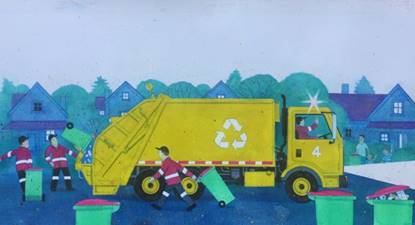
Your use of colour has always been distinctive and interesting, particularly with regard to the mix of medium you use, which is quite different in this age of computer colouring. Can you tell me how you create the textures of your colours?
I generally use watercolour and liquid acrylic in my pictures. I use a limited palette of the brightest blues, yellows, reds and greens that I can find. I generally mix the colours on the page rather than on the palette. I use watercolour for backgrounds, skies and faces because of its soft, translucent effect. Acrylic is waterproof so I often apply this first, because it stays put when I paint over the top with watercolour. For example, at the very start I often flick acrylic paint all over the paper to create a speckled, shimmering effect. For this image from The Rain Train, I used near-black acrylic for the trees, train and foreground. I then applied a blue wash right over the top, very quickly, flicking in a little red and green here and there. The marbled texture in the sky was achieved using a particular blue watercolour on rough paper.

Do you use a computer at all in your work?
No, I do not use a computer – I do spend a lot of time at a computer in my day-job and so enjoy the break from this technology when illustrating. I love the simple hands-on craft and age-old tradition of applying paint and line to paper. I would be far too fussy with a computer. The beauty of watercolour is that it is not conducive to reworking, so you cannot get bogged down. It rewards with surprising effects when you work fast and take risks. The illustrations do not take a long time to complete so I don’t mind if a picture is ruined and I have to start again.
I love the simple hands-on craft and age-old tradition of applying paint and line to paper. I would be far too fussy with a computer.
As I’m aware your day job is as a geothermal scientist, I wondered how you became an illustrator initially? Were you always an artist?
I have painted as a pastime all my life, encouraged at a young age by my mother. I was introduced to children’s book illustration quite by chance when I had a visit from a friend who worked in the children’s publishing industry, who suggested I try picture book illustration. The timing was fortuitous because Walker Books Australia was seeking a New Zealand illustrator for Sally Sutton’s book Roadworks. I had not previously considered children’s book illustration, but I had always been interested in graphic design and fashion illustration.
What attracts you to the manuscripts that you illustrate?
Manuscripts are presented to me by the publishers and I review the story and think about how I could illustrate the story in an interesting way. I enjoy illustrating movement and so I was naturally attracted to the captivating rhythm of Sally Sutton’s Roadworks series. I also love illustrating people and always think about how best to incorporate them into the stories. I was especially attracted to Elena de Roo’s The Rain Train because of the lyrical storyline and the drama and atmospheric effects I could bring to the illustrations. With Raymond Huber’s stories (Flight of the Honey Bee and Gecko) I was attracted by the challenge of illustrating wildlife – something I had not done before. Raymond’s stories brilliantly focus on the life of an individual bee and gecko and so the reader develops an empathy with the creatures. I needed to focus on this with the illustrations.
I enjoy illustrating movement and so I was naturally attracted to the captivating rhythm of Sally Sutton’s Roadworks series.
You’ve never shied away from shifting perspectives and you are great at adding depth to your illustrations, something we see in the fire engine spread in Wheels – is this something you consciously vary from spread to spread?
Yes, definitely. The composition is the most important part of my pictures and is developed at the storyboard stage (thumbnail cartoon-like spreads). I try to vary the perspective to add variety, but also to show the scene from the best angle, as in the roof-top image from Construction. Wheels is a guess-what’s-coming story so the most important thing is to portray anticipation of what will happen on the next page, as shown in the example below.
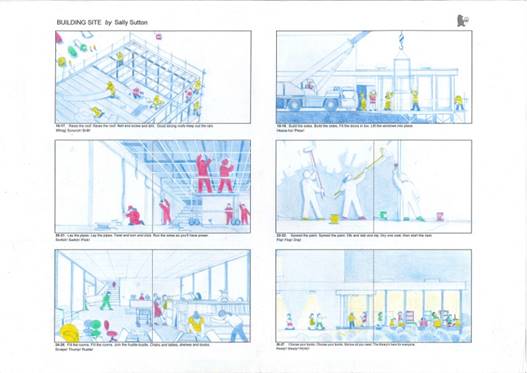
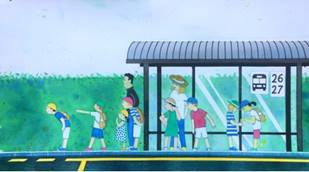
What is your favourite vehicle to draw?
Of all the machines in Sally Sutton’s stories, I think I most enjoy illustrating the excavators because of their size, the many articulating parts and their creature-like movements.
You’ve been in the children’s book industry over a decade now – what about your work has changed since you first began?
I have tried to bring the characters more to the fore, to add more interest to the stories. This is a challenge I enjoy – I have recently illustrated two books of poetry where people are the main subject. Overall, I continue to strive to develop a more expressive, looser and more colour-saturated style. I am inspired by artists like Brian Wildsmith.
I continue to strive to develop a more expressive, looser and more colour-saturated style.
How long do you typically take to complete illustrations for a book, from manuscript to final pages?
Because I have a day job, I only work part-time on illustrating and each book generally takes six to nine months to complete. After accepting a commission I prepare a storyboard, which is reviewed by the publisher and edited. I then proceed directly to the final illustrations. Each illustration takes up to a week to complete, but I repeat a lot of pictures…
My favourite book you illustrated is The Rain Train – what is your own favourite?
The Rain Train is also my favourite. There is something about trains travelling through the night that is very evocative and takes me back to my childhood.
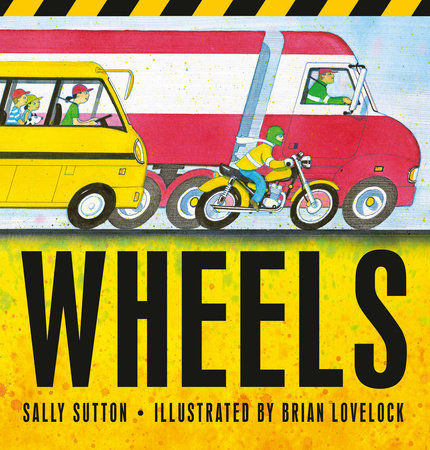

Brian Lovelock
Brian Lovelock is a children’s book illustrator and scientist. Lovelock was born in Marton, and he has lived in Christchurch, the Philippines, Auckland, and Taupō. He has been based in Auckland since 1994. He has worked as a geothermal scientist since 1979.



